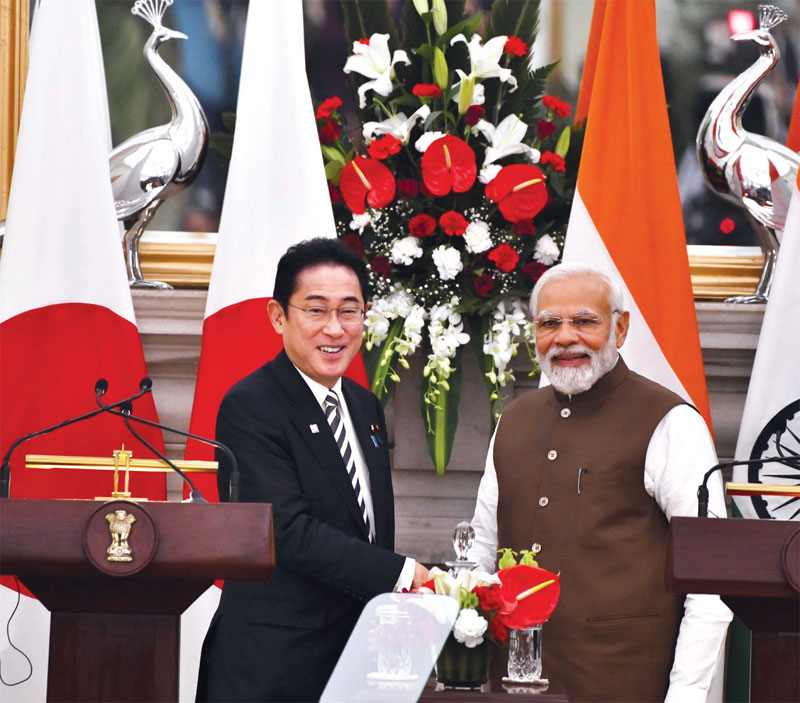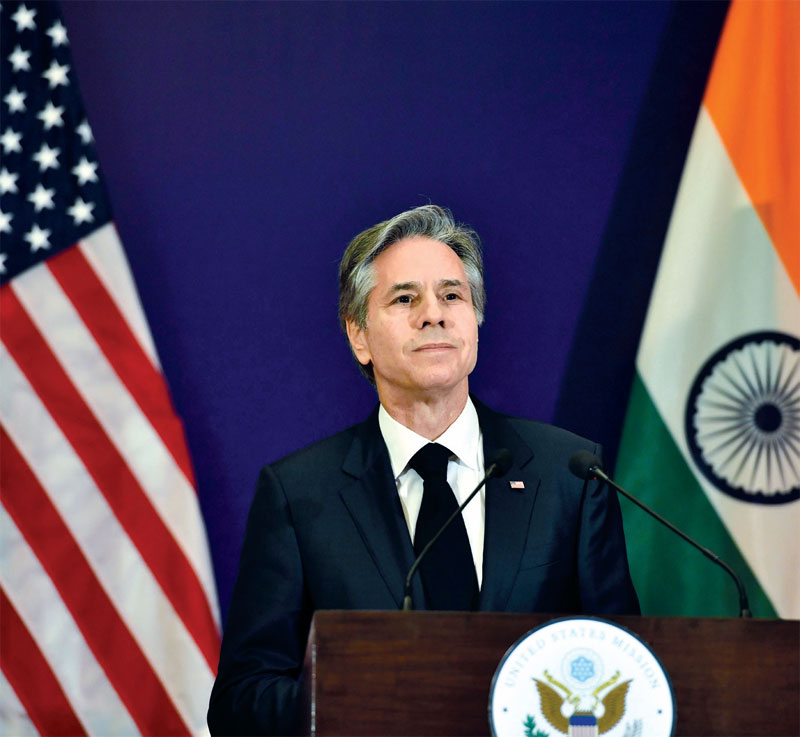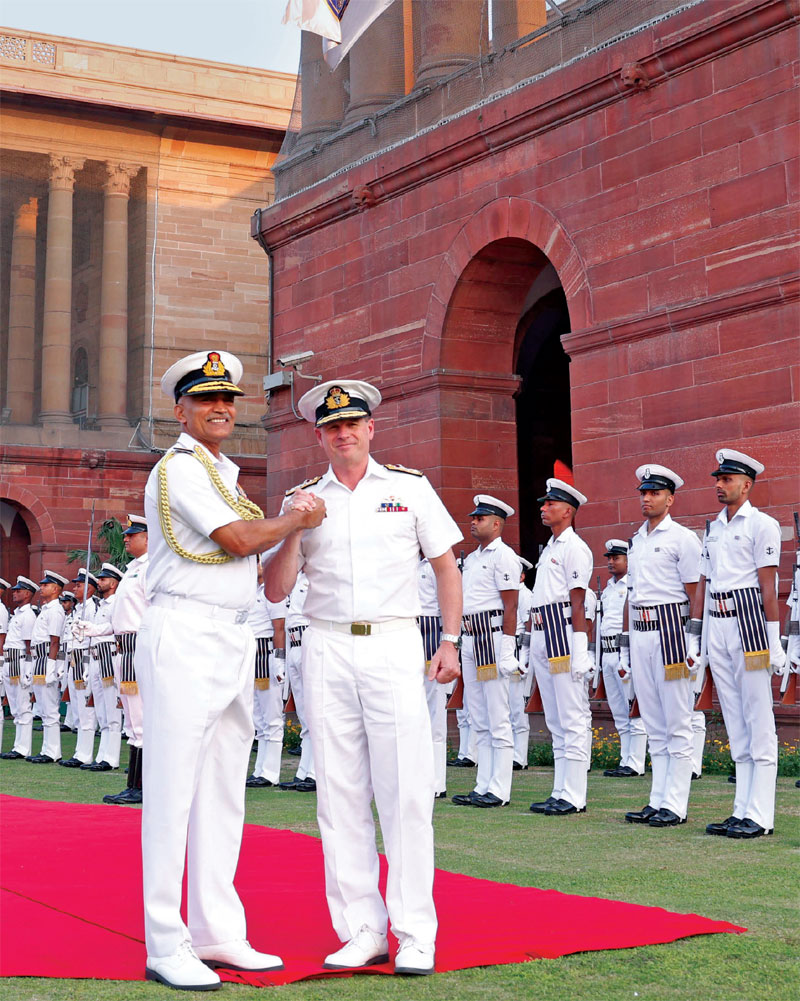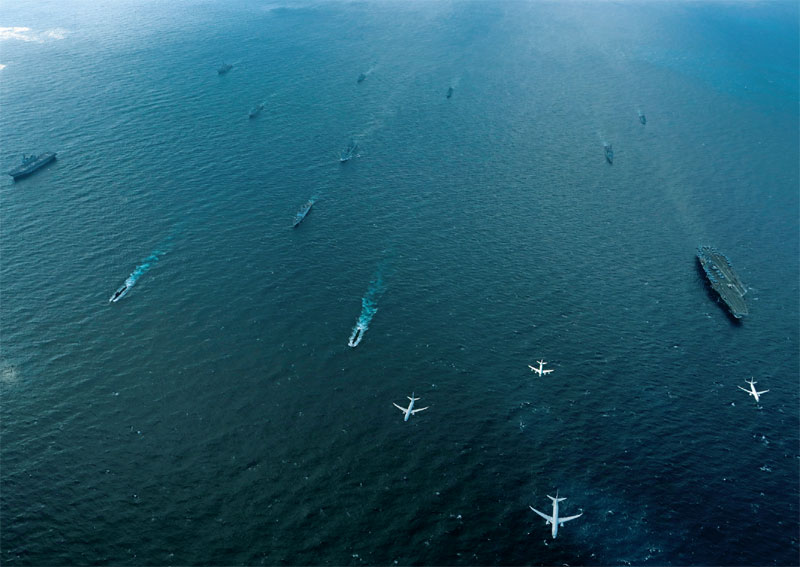Quad has come a long way since its tentatively beginnings after the great tsunami
Smruti Deshpande
The Quadrilateral Security Dialogue, or the Quad, is an informal strategic forum which includes the US, India, Japan and Australia. It was first established as a joint response to the devastating Boxing Day tsunami in the Indian Ocean in 2004. The grouping then met in 2007. The Quad was supposed to establish an ‘Asian Arc of Democracy’ but was hampered by a lack of cohesion among its members. It broke apart for several years before coming together again in 2017 given the convergence of security interests in the Indo-Pacific in the light of China’s rise.

China was quick to call it an anti-China bloc and ‘Asian Nato’. The Quad held its first formal meeting in 2021 and the grouping has maintained that its purpose is to deepen economic, diplomatic and military ties among the participating members. Most recently, ahead of the G20, the foreign ministers of these countries met in Delhi.
In a joint statement, the grouping said, ‘Our meeting today reaffirms the Quad’s steadfast commitment to supporting a free and open Indo-Pacific, which is inclusive and resilient.’ The Quad called for ‘the importance of adherence to international law’ in the East and South China Seas ‘to meet challenges to the maritime rules-based order.’ It added, ‘We express serious concern at the militarisation of disputed features, the dangerous use of coast guard vessels and maritime militia and efforts to disrupt other countries’ offshore resource exploitation activities.’
The grouping regularly holds military exercises—Malabar. The 26th edition of this exercise took place in November 2022 in the seas near Yokosuka in Japan. The exercise aimed at cooperation in the strategically significant Indo-Pacific region was hosted by the Japan Maritime Self Defence Force (JMSDF). The sea phase of Malabar-22 was conducted over a period of five days near Yokosuka and witnessed live weapon firings, surface, anti-air and anti-submarine warfare drills and tactical procedures. At the sea phase, the navies conducted the ‘War at Sea’ exercise, which enabled all four navies to consolidate interoperability and hone their tactical skills.
The high-tempo exercise saw the participation of 11 surface ships, including a nuclear-powered aircraft carrier with its integral air elements, along with four long-range maritime patrol aircraft, integral helicopters and two submarines. The exercise also involved exchange of ‘Sea Riders’ between various participating ships. Apart from operational drills and exercises, the bilateral logistics support agreements between the participating countries were validated during this edition of exercise Malabar. The Indian Navy was represented by the Eastern Fleet, which sent its stealth multirole frigate INS Shivalik and anti-submarine corvette INS Kamorta.
The 25th edition was hosted by the US Navy in the Western Pacific.
The Malabar series of exercises began in 1992, with a maritime drill between the navies of India and the US. In 2015, the JMSDF joined Exercise Malabar as a permanent member. The 2020 edition witnessed the participation of the Royal Australian Navy.
The Quad countries have also been involved in different defence trade and technology cooperation agreements to promote interoperability and standardisation of equipment. While India has been buying military equipment from the US worth millions of dollars, Japan and Australia too have been cooperating in the field of defence technology and equipment development. This explains the Quad’s move towards military interoperability.
India has bilateral ties with all the three Quad participants. While Malabar is one exercise that the countries undertake, India’s military also carries out bilateral exercises with the armed forces of Japan, Australia and the US. One commonality among these nations is that they are all democracies and upholders of democratic values.

India and Japan
India and Japan have both cultural and economic convergence. The two countries have healthy bilateral ties and are seeking to deepen them in the future. India and Japan established diplomatic relations on 28 April 1952. In 2007, India and Japan concluded a strategic agreement and published a joint declaration saying that this accord would become an ‘essential pillar for the future architecture’ of Asia. Since then, the two countries have signed a comprehensive economic partnership agreement and held preliminary talks on a potential civil nuclear deal. Earlier, Japan and India were unable to realise the full potential of their bilateral relations because of differing foreign policy stances. During the Cold War while Japan aligned with the US, India stuck to non-alignment.
With the China challenge in the Indo-Pacific, Japan and India have collaborated on several security matters and signed many agreements. In 2015 the two countries signed the Transfer of Defence Equipment and Technology and Security Measures for the Protection of Classified Military Information, and the Acquisition and Cross-Servicing Agreement (ACSA) in 2021. In 2022, they signed the Memorandum of Cooperation in the Field of Cybersecurity.
Furthermore in 2015, the ‘Japan and India Vision 2025’ expressed the two countries’ commitment to a ‘peaceful open, equitable, stable and rule based’ Indo-Pacific and the intention to promote quality infrastructure to augment connectivity in the region.
The Stimson Centre said in one of its reports titled Japan-India Security Cooperation: Progress Without Drama that under the new Japanese National Security Strategy, Japan’s security cooperation with India can be expected to steadily deepen as long as China remains India and Japan’s main and imminent security concern. ‘Meanwhile, there are no signs that Tokyo, much less Delhi, is intending to qualitatively upgrade this partnership into a formal alliance-like relationship involving a commitment to collective defence, which would surely create controversies between the two partners,’ it added.
The navies of Japan and India began bilateral exercise, JIMEX, in 2012. The two armies began conducting the exercise Dharma Guardian in 2018. Recently in 2023, the two countries participated in the inaugural edition of the 16-day bilateral air exercise between the Indian Air Force and the Japan Air Self-Defence Force (JASDF) in Japan. ‘The IAF and JASDF engaged in air combat manoeuvring, interception and air defence missions, both in visual and beyond visual range settings. Aircrew of the two participating air forces also flew in each other’s fighter aircraft to gain a deeper understanding of each other’s operating philosophies,’ the IAF said.
The two air forces also participated in Exercise Shinyuu Maitri in March 2023. The first phase of the exercise consisted of discussions on transport operations and tactical manoeuvring, followed by the second phase of flying drills by the IAF’s C-17 and JASDF C-2 transport aircraft.
India and US
India’s bilateral relations with the US has seen an upward trajectory in the past two decades. There has been a marked shift in India’s arms dependence. The major reason behind this was China’s rise, where India and the US see eye to eye when it comes to maintaining regional security and stability in the Indo-Pacific region.
The depth of the partnership was clearly visible in the recently-concluded Aero India 2023, where the US was the largest participant. The US Charge D’affaires to India, Elizabeth Jones, who led the delegation, said as India modernises its defence capabilities, the US wants to be the partner of choice. “We are focused on mutually beneficial co-production and co-development partnerships.” The air show saw a cross-section of US military weapon systems, some of which were displayed for the first time, and they even performed aerial demonstrations.
US Air Force’s fifth-generation fighters—F-35A Lightning II and F-35A Joint Strike Fighter—debuted at the air show. Two B-1B Lancer bombers roared in the skies for the second time at the show. Further, Lockheed Martin presented the F-21 fighter, C-130J transport aircraft, MH-60R Romeo multi-mission helicopter, Javelin weapon system and the S-92 multirole helicopter.
Weapon systems bought from the US are increasingly becoming a part of India’s arsenal, some of which have even been deployed on the frontlines such as eastern Ladakh. The C-17 Globemaster, C-130 and C-130J, Apache and Chinook helicopters, M-777 ultra-light howitzers and the P-8I surveillance aircraft are some of the major US-origin equipment used by India. Several US conglomerates such as Boeing and Lockheed Martin have established joint ventures in India to manufacture aircraft parts in India.
India has signed all the four foundational agreements with the US which forms the basis of its defence relationship with partner nations. These are General Security of Military Information Agreement (GSOMIA) signed in 2002, Logistics Exchange Memorandum of Agreement (LEMOA) signed in 2016, Communications Compatibility and Security Agreement (COMCASA) signed in 2018, and the Basic Exchange and Cooperation Agreement for Geo-spatial Cooperation (BECA) signed in 2020.
Apart from Malabar, the two countries conduct a range of joint military exercises, including Yudh Abhyas and Vajra Prahar exercises. In 2019, India-US held a nine-day humanitarian assistance and disaster relief (HADR) exercise code-named Tiger Triumph.
The two countries are a part of several common multilateral organisations, including the United Nations, G-20, Association of Southeast Asian Nations (Asean) Regional Forum, International Monetary Fund, World Bank and World Trade Organisation.
India is an Asean dialogue partner and an observer at the Organisation of American States. India is also a member of the Indian Ocean Rim Association (IORA) in which the US is a dialogue partner. In 2019, the US joined India’s Coalition for Disaster Resilient Infrastructure to expand cooperation on sustainable infrastructure in the Indo-Pacific region.
Interestingly, a paper published by the Stimson Centre said India’s alignment with the US stands at 20 per cent as opposed to 80 per cent for Japan and Australia. ‘The United States and India are at odds in multilateral forums despite their growing strategic proximity since 2000,’ the paper said.
Nikkei Asia reported last year that the Japanese government was planning to allow export of fighter jets, missiles and other arms to 12 countries, including India, Australia as well as certain European and Southeast Asian countries. Earlier in 2019, Japan and India were close to signing a deal for 12 amphibious military aircraft, but the deal was called off.

India and Australia
India’s defence relationship with Australia has been growing consistently. Both nations shared a dialogue on regional and global security issues at the inaugural India-Australia Strategic Dialogue held in New Delhi in 2001. Thereafter, the two countries signed a Memorandum on Defence Cooperation in 2006 and the Joint Declaration on Security Co-operation in 2009. In 2014, the two countries signed the bilateral Framework for Security Cooperation.
Post that, the defence relationship has grown to include a range of forums for strategic dialogue as well as regular interactions between the two militaries through visits, staff talk and training exchanges. The Indian Embassy stated that the Australia-India defence relationship now encompasses almost every major area of military partnership, namely strategic dialogue, coordination and information exchanges, including those involving third countries. Military exercises involving ground, air and maritime forces reflect a growing degree of interoperability with military-to-military exchanges, training, defence commerce and technological cooperation.
In 2022, on the side lines of the Malabar exercise, the defence ministers of India and Australia carried out a comprehensive review of the strategic challenges and the regional security matrix and reaffirmed their shared objective of an open, inclusive and rules-based Indo-Pacific.
A joint press statement released after the talks said Rajnath Singh and Richard Marles welcomed the plan to commence the landmark General Rawat Young Officer Exchange Programme in the latter half of 2022.
The programme was announced during the virtual summit between the prime ministers of the two countries in March in honour of India’s first Chief of Defence Staff General Bipin Rawat, who died in a helicopter crash in December 2021.
“The ministers reviewed strategic challenges and the regional security situation and reaffirmed their shared objective of an open, free, inclusive, prosperous and rules-based Indo-Pacific region,” the statement said.
The ministers reviewed the defence and security pillars of the India-Australia Comprehensive Strategic Partnership. In June 2020, India and Australia elevated their ties to a comprehensive strategic partnership and signed a landmark deal for reciprocal access to military bases for logistics support. The Mutual Logistics Support Agreement (MLSA) allows the militaries of the two countries to use each other’s bases for repair and replenishment of supplies, besides facilitating scaling up of overall defence cooperation.
Moreover, as per a report in India Today, an Indian firm is negotiating a deal to supply made-in-India drones to the Australian Navy. The drone firm got help from the Indian Navy to develop its products, including the human-carrying Varuna drone, which was showcased by Prime Minister Narendra Modi during an event.

“The firm is negotiating the project with the Royal Australian Navy through their local partner to sell them the made-in-India Varuna drones,” senior navy officials told India Today TV.
Indian and Australian forces conduct the several military exercises. In 2022, as part of Australia’s Indo-Pacific Endeavour 2022 (IPE 22), the Australian Defence Forces were hosted by the Eastern Naval Command. Ships of the Indian Navy’s Eastern Fleet as also personnel from the Indian Army and the IAF participated in various joint activities.
The two armies also participated in the Austra Hind bilateral exercise last year in Rajasthan. It was the first in the series of Austra Hind bilateral exercises and comprised joint training operations in semi-desert terrain under the UN peace enforcement mandate.
The harbour phase included a wide range of professional interactions including experience sharing, joint planning activities and friendly sports exchanges. The successful completion of the exercise marks another milestone in the growing India-Australia military interactions.
The same year, Exercise Pitch Black-22 was hosted by the Royal Australian Air Force at its Darwin Air Base. Spanning over three weeks, the exercise saw the participation of 17 air forces and over 2,500 military personnel. The IAF contingent included four Su-30 MKI and two C-17 aircraft. The participating forces took part in various multi-aircraft combat drills.
Similarly, the navies of the two countries also performed the AUSINDEX exercise in India last year. The P8A aircraft of the Royal Australian Air Force (RAAF) arrived in Goa and interacted with the P8I squadron INAS 316 at INS Hansa. The RAAF P8A and the Indian Navy’s P8I aircraft will undertake coordinated operations involving Anti-Submarine Warfare and Surface surveillance. Previously, Indian Navy’s P8I aircraft had operated from Darwin, Australia in April 2022 and undertaken coordinated operations with RAAF P8A in the Northern Australian waters.

